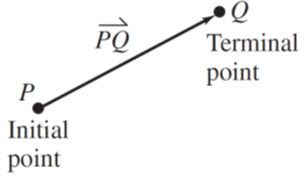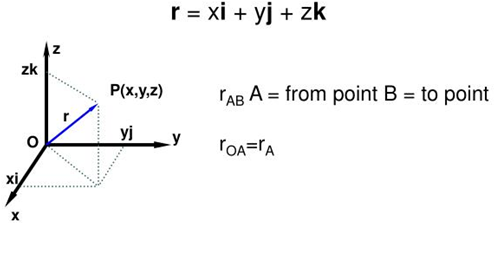Many quantities in geometry and physics, such as area, time, and temperature are presented using a single real number. Other physical and algebraic quantities, such as velocity and momentum, have both magnitude and direction and cannot be completely characterized by a single real number. A scalar quantity can be described by a single number characterized by either a +ve or -ve sign. A vector quantity needs both a magnitude and a direction in space for a complete description. A vector quantity is represented in boldface italic type with an arrow over it:$
\overrightarrow{A}$. The magnitude of A is written as A or $\overrightarrow{\vert A\vert }$. A line pointing in one direction is a directed line and if it is bound by two points we obtain a directed line segment, eg.$\overrightarrow{PQ}$, read as ‘vector $\overrightarrow{PQ}$’. In this case, point P is the initial point while point Q is the terminal point of the vector. This form of vector representation is called the standard form.

A vector with initial point is at the origin (0, 0) are represented by the coordinates of its terminal point (a$_{1}$, a$_{2}$). This is the component form of a vector $\overrightarrow{A}$,written as $\overrightarrow{A}=\langle a_{1}, a_{2}\rangle $in 2D space.The component form with initial point P (p$_{1}$, p$_{2}$) and terminal point Q (q$_{1}$, q$_{2}$) can be given by:
$\overrightarrow{PQ}=\langle q_{1}-p_{1}, q_{2}-p_{2}\rangle =\langle a_{1}, a_{2}\rangle =\overrightarrow{A}$
$\Vert \overrightarrow{A}\Vert =\sqrt{(q_{1}-p_{1})^{2}+(q_{2}-p_{2})^{2}}$
$=\sqrt{a_{1}^{2},+a_{2}^{2}}$
Position vector: Consider a directed line segment $\overrightarrow{AB}$ in the figure below. In a three-dimensional space, the vector $\overrightarrow{AB}$has O as its initial point and P as its terminal point. The position vector $\overrightarrow{r}$ can be used to define the fixed vector that locates the point P in space relative to another point O which is the origin.

The magnitude of $\overrightarrow{AB}$ can be calculated using the distance formula: $\vert \overrightarrow{AB}\vert =\sqrt{x^{2}+y^{2}+z^{2}}$
Properties of vectors:
- A vector can be moved anywhere in a plane if the magnitude and direction are not changed.
- Two vectors are equal if both contain the same magnitude and direction regardless of the position on the plane.
- Vectors are concurrent when they act on a point at the same instance.
- A vector multiplied by a scalar will result in a vector with the same direction and a larger magnitude.
- Two or more vectors can be added together to form a resultant. The resultant is a single vector that can be used to replace the other vectors by performing algebraic operations on them.
- The maximum value for a resultant vector occurs when the angle between the vectors under consideration is 0°.
- The minimum value for a resultant vector occurs when the angle between the two vectors under consideration is 180°.
- The equilibrant is a vector with the same magnitude but in the opposite direction to the resultant vector.